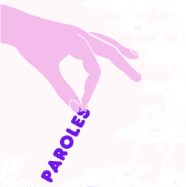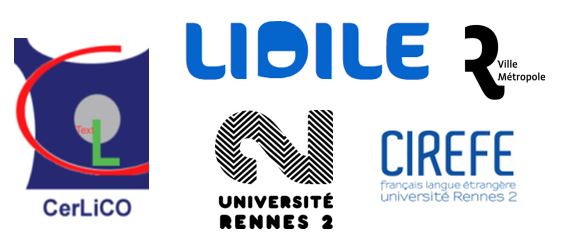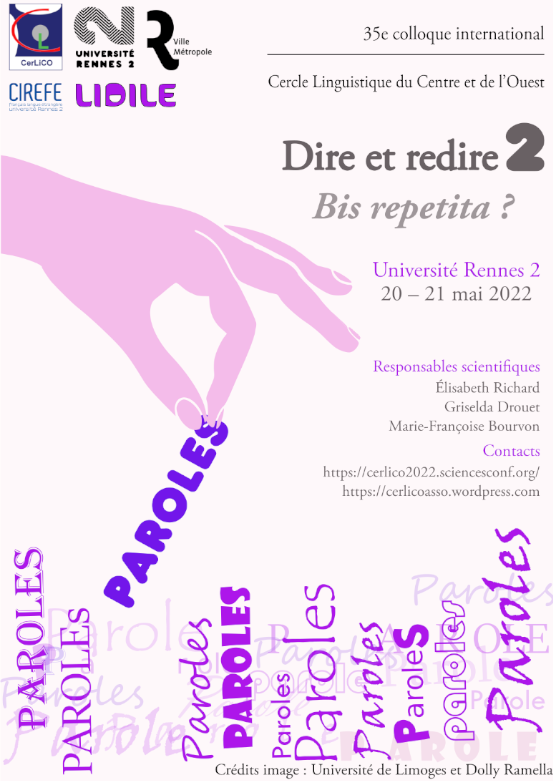|
Appel à communications
APPEL À COMMUNICATIONS 35e colloque international du CerLiCO Cercle Linguistique du Centre et de l’Ouest Université Rennes 2 Vendredi 20 – samedi 21 mai 2022 ***inscriptions ouvertes jusqu'au 8 mai 2022*** **Pour adhérer à l'association du CerLICO, suivre ce lien: https://cerlicoasso.wordpress.com/bulletin-dadhesion/
Dire et re-dire : bis repetita ?
Responsables scientifiques Élisabeth Richard, Griselda Drouet, Marie-Françoise Bourvon
Émaillée de reprises constantes, la langue se cherche et le discours s’étaye en se re-disant. Prenant la suite du 34e colloque du CerLICO, organisé par le CeReS à l’Université de Limoges en 2021, LIDILE accueille le 35e colloque international du CerLiCO à l’Université Rennes 2, les 20 et 21 mai 2022. Dire et re-dire : bis repetita ? interrogera la redite, ses paramètres et variabilités, d’un point de vue linguistique, traductologique et didactique. Nous ouvrons la réflexion à tous les types de corpus authentiques, écrits et oraux, des plus vastes aux plus spécifiques (corpus d’apprenants, médicaux, politiques, commerciaux, etc.), aux corpus parallèles et comparables de la traduction, ainsi qu’aux corpus didactiques. Toutes les langues et combinaisons de langues peuvent être soumises à l’étude. Aucun cadre théorique n’est exclu à la condition d’être explicité. Le CerLiCO invite les participants à proposer des communications autour des trois axes suivants : 1. Études linguistiquesLes communications pourront s'attacher à délimiter les formes écrites et orales (énonciatives, lexicales, morphologiques, syntaxiques, phonétiques, pragmatiques) qui re-disent et leur inscription dans le discours. À partir de quand considérer qu’il y a redite ? Dit-on la même chose, progresse-t-on dans le discours et si oui comment, et comment dire que l’on va (se) redire ? Comment repère-t-on la redite et l’empan de la redite ? On observera la répétition comme une des contraintes de l’axe syntagmatique qui dit et re-dit, qui reformule, qui reprend et tisse ainsi sa cohérence, sa cohésion, au fur et à mesure qu'il se construit. D’un point de vue phonétique et phonologique nous nous intéresserons aux variations qui changent l’interprétation : de l’interrogation au pastiche, du sarcasme à la colère, en passant par la moquerie par exemple. Les études pourront aussi être menées autour des visées argumentatives ou pragmatiques qu’offre la langue pour reprendre et signifier la même chose ou autre chose. On s'interrogera donc sur les différentes fonctions de la redite dans la linéarité du discours, sur la différence entre auto-reformulation et hétéro-reformulation. Par ailleurs, nous intégrerons dans cet axe de réflexion les recherches sur les corpus : comment annoter la reformulation, selon les types d’énonciateurs dans l’interaction, les types de discours, de texte ? Quels sont les schémas repérables de la répétition et de la reformulation ? Y-a-t-il une unité de la redite ? Comment la mesure-t-on ? Du point de vue de la détection informatique et de l’apprentissage homme/machine : quelles sont les méthodes de détection et de distinction automatique entre la répétition et la reformulation ? 2. Traduction, interprétation, rédaction techniqueLe colloque accueillera également des recherches en traduction, en interprétation et en rédaction technique. Si la traduction consiste immanquablement à redire autrement, elle appelle aussi, du fait que la redite intervient entre des langues-cultures différentes, une réflexion sur ce qui doit être dit, ajouté, explicité, peut ne pas être redit, voire ne doit pas être redit. On peut interroger les seuils d'acceptabilité que les notions de dire et redire, dans une traduction, engendrent en fonction des langues-cultures de travail, des types de texte, de leur finalité. À cet égard, les travaux en traductologie de corpus sont particulièrement pertinents pour relever des tendances, par exemple entre textes traduits et non traduits d’une même langue, ce qui renvoie éventuellement à l’existence d’universaux de traduction, ou des contrastes entre langues sources et langues cibles. La fameuse note du traducteur ne trouve ainsi pas place dans le sous-titrage que font les professionnels de la traduction audiovisuelle, alors qu’on en voit dans les sous-titrages dits « sauvages » (fan-subbing). Les répétitions, elles, peuvent être plus acceptables dans certaines langues que dans d’autres. Les communications pourront également aborder le domaine de la révision, à partir de traductions tant humaines qu'automatiques. Les outils d’aide à la traduction et à la rédaction constituent-ils alors un frein ou un soutien ; imposent-ils l’uniformisation terminologique ou permettent-ils au traducteur de laisser son empreinte ? Dans le domaine de la rédaction technique, le colloque sera l’occasion d’interroger en particulier le dire des informateurs auxquels le rédacteur technique fait appel et même, en amont, le faire dire du rédacteur technique. Ces deux dires pourront être mis en regard du redire du rédacteur, après compréhension de ce qui est à communiquer aux utilisateurs de ses textes. Le thème général du colloque appelle enfin à questionner le travail de l'interprète, physiquement présent au moment de l’énonciation, et à analyser en quoi son redire se distingue de celui du traducteur. Le dire dont l’interprète prend l’initiative, en plus du redire de la première énonciation, dans une situation donnée, sera intéressant à étudier de même que, de manière spécifique à son activité, l’hésitation et la reformulation qui lui permettent éventuellement d’aboutir au redire voulu par rapport à cette énonciation. 3. Didactique des languesLes études présenteront les différentes problématiques didactiques liées aux procédés, aux formes, aux stratégies du dire et du re-dire tant du point de vue de l’apprenant que de l’enseignant. Le passage de l'approche audio-orale structuraliste, fondée sur la répétition de formes, à l'approche communicative et à la perspective actionnelle prônant l’expression libre a-t-il définitivement supprimé le redire de l’espace pédagogique ? Entre artifice et réalité d’apprentissage des langues, la redite peut-elle être considérée comme une stratégie d’enseignement/d’apprentissage efficiente ? Dans la multiplicité des formes de la redite, comment prendre en considération les paramètres que représentent le contexte d’enseignement/apprentissage, le niveau des apprenants, le type de tâches et les contraintes de consignes ? En classe, les reformulations de l’enseignant ont pour fonction de structurer les connaissances. L’enseignant est amené à reformuler ses propres paroles ainsi que les réponses des apprenants. Mais la reformulation, de la consigne par exemple, n’est-elle pas précédée d’une répétition à l’identique du premier énoncé ? La reformulation de la parole de l’apprenant ne commence-t-elle pas par une reprise de sa réponse ? On pourra s’intéresser à la co-présence, à la succession de ces deux moments, répétition et reformulation, en cours de langue étrangère. La re-dite en dit-elle plus ou moins ? utilise-t-elle la périphrase ? la traduction ? la gestuelle ? la transcription en API ? Côté apprenant, redire est remis en question quand il s’agit de répétition. En revanche, les activités de médiation écrite et orale, qui relèvent pourtant bien de la re-dite, sont plébiscitées dans le Volume complémentaire du CECRL (2018). Si le plus souvent il est demandé à l’apprenant-utilisateur de résumer, d’ « élaguer un texte » et « d’éliminer les répétitions et les digressions », il peut aussi s’agir pour lui « d’amplifier un texte dense » pour le rendre plus compréhensible et pour cela d’« utiliser la répétition et la redondance, par exemple en paraphrasant de différentes façons » (ibid : 133). On pourra se demander comment les activités de médiation écrite et orale peuvent concrètement engager apprenants (et enseignants) à ne pas considérer systématiquement la répétition comme une erreur à traquer mais comme faisant partie des « stratégies de médiation » à développer. Bibliographie indicativeAUTHIER-REVUZ Jacqueline (2020), La représentation du discours autre, principes pour une description, Berlin/Boston, De Gruyter. AUTHIER-REVUZ Jacqueline (1995), Ces mots qui ne vont pas de soi : boucles réflexives et non-coïncidences du dire, tomes 1 et 2, Paris, Larousse. BASTIN George (1990), « Traduire, adapter, réexprimer », Meta: le journal des traducteurs, vol. 35, n° 3, p. 470-475. BOT Hanneke (2005), « Dialogue Interpreting as a specific case of reported speech », Interpreting, Vol.7-2, p. 237-261. CHEVALIER Jean-Claude & DELPORT Marie-France (2006), « Traduction, traductologie et linguistique », in Michel Ballard, Qu’est-ce que la traductologie ? Arras : Artois Presses Universités (collection « Traductologie »), p. 119-132. GARCIA-DEBANC Claudine (2006), « Une méthodologie pour déterminer les objets effectivement enseignés : l'étude des reformulations dans l'interaction didactique » in Bernard Schneuwly et Thérèse Thévenaz-Christen (ed.), Analyse des objets enseignés : le cas du français. De Boeck Université, p. 111-141. CORNISH, Francis (1999), Anaphora, Discourse, and Understanding. Evidence from English and French. Oxford University Press. DE GAULMYN Marie-Madeleine (1987a), « Actes de reformulation et processus de reformulation », in Bange Pierre, La Dame de Caluire: une consultation, p. 83-98. DE GAULMYN Marie-Madeleine (1987b), « Reformulation et planification métadiscursives », in Cosnier Jacques & Kerbrat-Orecchioni Catherine (éds), Décrire la conversation, Lyon : Presses Universitaires de Lyon, p. 167- 198. FUCHS Catherine (1994), Paraphrase et énonciation, Paris : Ophrys. GÜLICH Elisabeth & KOTSCHI Thomas (1987), « Les actes de reformulation dans la consultation », in Bange Pierre, La Dame de Caluire : une consultation, p. 15-81. HENRY Jacqueline (2016), « Reformuler, réécrire, recréer… : des concepts connexes à la verbalisation en traduction », TTR, 29-1, p. 17-31. KARA Mohammed (éd.), (2007), Usages et analyses de la reformulation, Recherches linguistiques, n° 29. LANDOLSI Houda, SVENSSON Maria et NORÉN Coco (éds) (2019), La reformulation, à la recherche d’une frontière, Uppsala: Acta Universitatis Upsaliensis, 293 p. LE BOT Marie-Claude, SCHUWER Martine & RICHARD Élisabeth (éds) (2008a), La reformulation. Marqueurs linguistiques. Stratégies énonciatives, Rennes : Presses universitaires de Rennes. LE BOT Marie-Claude, SCHUWER Martine & RICHARD Élisabeth (éds) (2008b), Pragmatique de la reformulation. Types de discours. Interactions didactiques, Rennes : Presses universitaires de Rennes. LOOCK Rudy (2016), La traductologie de corpus, Villeneuve-d’Ascq : Presses universitaires du Septentrion. MARTINOT Claire, ROMERO Clara (éds), (2009), « La reformulation : acquisition et diversité des discours », Les cahiers de praxématique, 59, Montpellier : Presses universitaires de la Méditerranée. MARTINOT Claire, BOŠNJAK BOTICA Tomislava, GEROLIMICH Sonia & PAPROCKA-PIOTROWSKA Urszula (2018), Reformulation et acquisition de la complexité linguistique, , Londres, Royaume-Uni : ISTE editions. MARTINOT Claire (2019), « Comment la reformulation articule la contrainte syntaxique et la contrainte sémantique : illustration dans la langue des enfants et des adultes », Acta universitatis Upsaliensis. Studia Romanica,numéro 87, in Houda Landolsi, Maria Svensson et Coco Norén (éds) La reformulation, à la recherche d’une frontière, Uppsala: Acta Universitatis Upsaliensis, 19-35. MIGEOT François & VIPREY Jean-Marie (éds.) (2000), Répétition, Altération, Reformulation, Actes du colloque international des 22 au 24 juin 1998, Besançon : Presses Universitaires franc-comtoises. PAISSA Paola etDRUETTA (2019), Ruggero, éd. La répétition en discours. Louvain-la-Neuve, Belgique: Academia-l’Harmattan. PENNEC Blandine (2017), Les phénomènes de réajustement du discours en anglais contemporain, Londres Royaume-Uni : ISTE éditions. PEYTARD Jean, JACOBI Daniel, PETROFF André (éds) (1984), Français technique et scientifique : reformulation, enseignement, Langue française, n°64, Paris : Larousse. PRAK-DERRINGTON Emmanuelle (2021), Magies de la répétition, Collection Langage, Lyon : ENS éditions. RABATEL Alain, MAGRI Véronique (éds) (2015), La répétition lexicale : approche discursive et pragmatique, SEMEN, 38. RICHARD Élisabeth (2014) Parcours de la répétition – Un cercle dynamique, Synthèse d’Habilitation à Diriger des Recherches, Strasbourg. RICHARD Élisabeth (2002), La répétition : syntaxe et interprétation. Thèse de doctorat. UBO-Brest. RIEGEL Martin & TAMBA Irène (éds) (1987), La reformulation du sens dans le discours, Langue française, n°73, Paris : Larousse. ROSSARI Corinne (1997), (2e éd.), Les opérations de reformulations, Bern : Peter Lang. SCHNEDECKER Catherine (2021), Les chaînes de références en français, Paris : Ophrys. SELESKOVITCH Danica & LEDERER Marianne (2014, 1re éd. en 1984), Interpréter pour traduire, Paris : Publications de la Sorbonne / Didier Érudition. LEEKANCHA Intareeya (2021), Reformulation et discours touristiques: analyse linguistique, Thèse de doctorat sous la direction de E. Richard, LIDILE, Université Rennes 2. LONGUET Frédérique, SPRINGER Claude (éds), 2021, Autour du CECR - Volume complémentaire (2018) : médiation et collaboration. Une didactique de la relation écologique et sociosémiotique, Éditions des archives contemporaines, France, 362p. STEUCKARDT Agnès & NILAS-SALMINEN Aïno (éds) (2003), Le mot et sa glose, Publications de l’Université de Provence. TANNEN Deborah (2007), Talking Voices, Repetition, Dialogue, and Imagery in Conversational Discourse, rééd. 2007 (éd. or. 1989) augmentée d'une nouvelle introduction, Cambridge : Cambridge University Press. Comité d’organisationCatrin Bellay, Marie-Françoise Bourvon, Clara Destais, Griselda Drouet, Aura Duffé, Christine Evain, Thomas Gaillat, William Kelleher, David Le Roux, Jenyu Li, María Lomeña Galiano, Margarita Munoz-Garcia, Dolly Ramella, Elisabeth Richard, Cristian Valdez. Comité scientifiqueSophie Anquetil (U. de Limoges), Encarnación Arroyo González (U. de Toulouse), Marie Françoise Bourvon (U. Rennes 2), Katarina Chovancova (UMB, Banská-Bystrica, Slovaquie), Marie-Ange Dat (U. de Nantes), Claire Doquet (U. de Bordeaux), Sophie Dufossé (U. de Limoges), Griselda Drouet (U. Rennes 2), Thomas Gaillat (U. Rennes 2), Djaouida Hamdani (UQUAM, Canada), Meri Larjavaara (Åbo Akademi), Cindy Lefebvre-Scodeller (U. de Limoges), Intareeya Leekancha (U. de Thaïlande), David Le Roux (U. Rennes 2), María Lomeña Galiano (U. Rennes 2), Margarita Munoz-Garcia (U. Rennes 2), Sylvester Osu (U. de Tours), Blandine Pennec (U. de Toulouse), Olivier Polge (U. de Limoges), Élisabeth Richard (U. Rennes 2), Audrey Roig (U. de Paris), Cristian Valdez (U. G. Eiffel, Marne la Vallée), Bernadeta Wojciechowska (UAM, Pologne). Modalités de soumissionLes propositions sont à envoyer avant le 15 octobre 2021. Elles comporteront une présentation de la problématique et des données (environ 500 mots / 3000 signes) ainsi qu’une brève bibliographie. Elles pourront être rédigées en français ou en anglais. Les propositions seront examinées anonymement par deux membres du comité scientifique. Elles sont à envoyer directement sur la plateforme Sciencesconf CERLICO 2022 à l’adresse suivante : https://cerlico2022.sciencesconf.org Pour la publication qui suivra, les articles rédigés seront demandés dès le mois de juin 2022. Informations pratiquesLes communicants disposeront de 30 minutes pour leur exposé, qui sera suivi d’une discussion de 10 minutes. Une sélection d’articles fera l’objet d’une publication. Date limite d’envoi des propositions : 5 novembre 2021 Date de notification aux auteurs : début décembre 2021 Montant des droits d’inscription au colloque : à préciser Dates du colloque : 20-21 mai 2022 Date de transmission des articles rédigés : 30 juin 2022 Lieu : Université Rennes 2, Place du Recteur Henri Le Moal, 35000 Rennes. Les résumés seront diffusés lors de l’inscription au colloque et accessibles sur le site web du CerLiCO. Les informations seront disponibles sur le site du CerLiCO (https://cerlicoasso.wordpress.com/) ainsi que sur la plateforme Sciencesconf (https://cerlico2022.sciencesconf.org).
|




